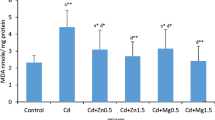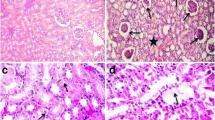Abstract
Cadmium (Cd)-induced nephropathy was treated by triethylene-pentaminehexaacetic acid (TTHA) in male Syrian hamsters. Hamsters injected three times a week with 3 mg/kg body wt CdCl2 showed proteinuria, urinaryN-acetyl-β-d-inglucosaminidase (NAG), and fractional excretion of sodium (FENa) when compared to saline-injected control. Cd-treated hamsters injected ip with TTHA 10 mg/kg body wt five times a week showed reduction of renal damage, including reductions in urinary protein (from 6.7±2.2 to 4.3±0.5 mg/d) and NAG (0.17±0.06 to 0.04±0.02 U/d). Urinary excretion of Cd was significantly increased (from 87±51.3 to 3052±1485 mg/L) by TTHA administration. Cd concentration in renal cortical tissue was slightly reduced (26.4±3.0 to 21.8±2.7 mg/g. protein). Excretion of malondialdehyde (MDA) was increased only in Cd-injected hamsters (to 2.1±1.6 nM/L), and elevated MDA in renal cortical tissue was not reduced by the administration of TTHA (1041±105 vs 1104±358 nM/g protein). Glutathione (GSH) concentration in the renal cortex was significantly elevated after Cd administration and further increased after TTHA administration (5.5±2.1 to 9.8±2.0 μg/50 mg protein). There were no marked effects on creatinine clearance (Ccr) and hematocrit. Moreover, renal morphological changes were improved significantly by treatment with TTHA.
We demonstrated the efficacy of TTHA in the treatment of Cd-induced nephropathy in hamsters. Although the precise mechanism of the TTHA effects on Cd-induced nephropathy has not been elucidated, it might involve GSH reducing the elevated MDA concentration in renal tissue.
Similar content being viewed by others
Refereces
K. Nomiyama, inHandbook of Experimental Pharmacology, vol. 80, E. C. Foulkes, ed., Springer-Verlag, Berlin, p. 101 (1986).
G. F. Nordberg, and M. Piscator,Environ. Physiol. Biochem 2, 37 (1972).
Y. Suzuki,J Toxicol. Environ. Health 6, 469 (1980).
S. Rehm and M. P. Waalkers,Toxicol. Appl. Pharmacol. 104, 94 (1990).
T. Shibasaki, I. Ohno, F. Ishimoto, and O. Sakai,Jpn. J. Nephrol. 35, 913 (1993).
T. Shibasaki, H. Nakano, I. Ohno, F. Ishimoto, and O. Sakai,Biol. Trace Element Res. 37, 261 (1993).
V. Eybl, J. Sykora, and F. Mertl,Acta Biol. Med. Germa 16, 149 (1966).
M. M. Jones and M. G. Cherian,J. Toxicol. 62, 1 (1990).
A. Noto, Y. Ogawa, and S. Mori,Clin. Chem. 293, 1713 (1983).
O. H. Lowry, N. J. Rosebrough, A. L. Farr, and R. J. Randal,J. Biol. Chem. 193, 265 (1951).
H. Ohkawa, Y. Ohnishi, and K. Yagi,Anal. Biochem. 95, 351 (1979).
C. W. Owens and R. V. Belcher,Biochem. J. 94, 705 (1965).
T. Shibasaki, Q.-Y. Xu, I. Ohno I, F. Ishimoto F, and O. Sakai,Biomed. Res. Trace Elements 4, 93 (1993).
L. Friberg,AMA Arch. Ind. Health 13, 18 (1956).
W. M. Bennett,Nephron 35, 73 (1983).
R. G. Schnellman,J. Biochem. Toxicol. 6, 299 (1991).
Author information
Authors and Affiliations
Rights and permissions
About this article
Cite this article
Shibasaki, T., Xu, Q.Y., Ohno, I. et al. Effect of triethylenepentaminehexaacetic acid on the renal damage in cadmium-treated Syrian hamsters. Biol Trace Elem Res 50, 157–165 (1995). https://doi.org/10.1007/BF02789418
Received:
Revised:
Accepted:
Issue Date:
DOI: https://doi.org/10.1007/BF02789418




